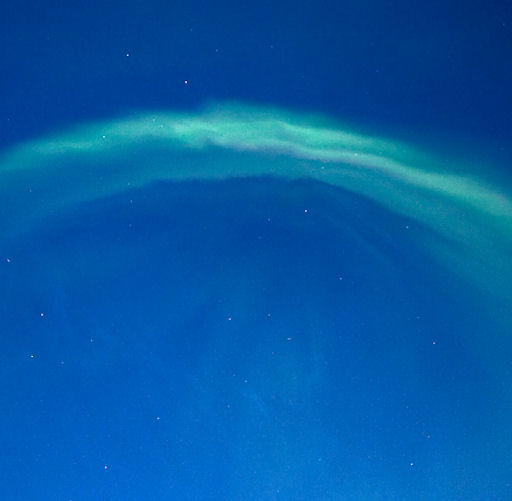CURIOSITY ZAPS FIRST MARTIAN ROCK: A laser on Curiosity has fired for the first time on Mars, zapping a fist-size rock named "Coronation." Light reflected from the resulting plasma cloud reveals the rock's chemical make-up. In all, Coronation was hit by 30 pulses, each delivering more than a million watts of power for about 5 nano-seconds. [full story]
ARCTIC AURORA SEASON BEGINS: The long days of northern summer are coming to an end, and auroras are appearing in the darkening Arctic skies. "Yesterday I saw my first stars since last spring, and tonight the first auroras!" reports Fredrik Broms, who sends this picture from Kvaløya, Norway:
"It felt almost unreal to see them dancing across the light blue sky where only Jupiter, Venus and the brightest of the stars were visible," adds Broms. "I saw both green and red rays dancing over my head while standing barefoot in the grass - a somewhat unusual combination here in Tromsø! The return of the auroras was most welcome after a summer without any stars (save one)."
More arctic auroras are in the offing tonight as a high-speed solar wind stream buffets Earth's magnetic field. NOAA forecasters estimate a 25% to 30% chance of polar geomagnetic storms. Aurora alerts: text, phone.
RED SPRITES: High above Earth in the realm of meteors and noctilucent clouds, a strange and beautiful form of lightning dances at the edge of space. Researchers call the bolts "sprites"; they are red, fleeting, and tend to come in bunches. Jesper Grønne of Silkeborg, Denmark, photographed these specimens on August 15th:
"After several years of hunting sprites from my location in Denmark, I finally caught some last week--the first danish Red Sprites ever photographed," says Grønne. "They were located 50 km to 90 km above a thunderstorm some 350 km away over the North Sea. There were 2 flashes, each producing 5-6 individual Red Sprites."
"Sprites are a true space weather phenomenon," explains lightning scientist Oscar van der Velde of Sant Vicenç de Castellet, Spain. "They develop in mid-air around 80 km altitude, growing in both directions, first down, then up. This happens when a fierce lightning bolt draws lots of charge from a cloud near Earth's surface. Electric fields [shoot] to the top of Earth's atmosphere--and the result is a sprite. The entire process takes about 20 milliseconds."
Although sprites have been seen for at least a century, most scientists did not believe they existed until after 1989 when sprites were photographed by cameras onboard the space shuttle. Now "sprite chasers" routinely photograph sprites from their own homes. "I used an astro-modified Canon 5D II in video-mode to catch my sprites," says Grønne. Give it a try!

![]()
Solar wind
speed: 540.9 km/sec
density: 1.7 protons/cm3
explanation | more data
Updated: Today at 1517 UT
![]()
X-ray Solar Flares
6-hr max: B5 0903 UT Aug20
24-hr: B6 0643 UT Aug20
explanation | more data
Updated: Today at: 1500 UT
![]()
![]()
![]()
Daily Sun: 18 Aug 12
![]()
![]()
None of the sunspots on the Earthside of the sun pose a threat for strong flares, but a potent farside active region is approaching from just behind the NE limb. Credit: SDO/HMI
![]()
![]()
![]()
Sunspot number: 69
What is the sunspot number?
Updated 18 Aug 2012
Spotless Days
Current Stretch: 0 days
2012 total: 0 days (0%)
2011 total: 2 days (<1%)
2010 total: 51 days (14%)
2009 total: 260 days (71%)
Since 2004: 821 days
Typical Solar Min: 486 days
Update 18 Aug 2012
The Radio Sun
10.7 cm flux: 98 sfu
explanation | more data
Updated 18 Aug 2012
![]()
![]()
![]()
Current Auroral Oval:
![]()
Switch to: Europe, USA, New Zealand, Antarctica
Credit: NOAA/POES
![]()
![]()
![]()
Planetary K-index
Now: Kp= 3 quiet
24-hr max: Kp= 4 unsettled
explanation | more data
![]()
Interplanetary Mag. Field
Btotal: 4.6 nT
Bz: 2.3 nT south
explanation | more data
Updated: Today at 1517 UT
![]()
![]()
![]()
Coronal Holes: 17 Aug 12
![]()
![]()
Earth is inside a stream of solar wind flowing from the indicated coronal hole. Credit: SDO/AIA.





